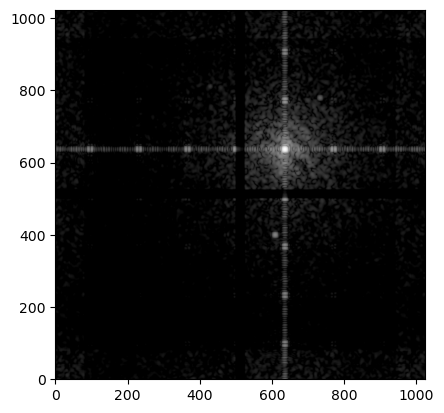焦面图像仿真模块说明
简介
焦面仿真模块读取观测目标的坐标和光谱,结合星冕仪的光电效率曲线和点扩散函数等,生成焦面处以光电子为单位的图像。
本模块包括如下功能模块:
焦面图像生成功能
焦面掩膜功能
系统透过率功能
可以使用焦面仿真模块中的filter_throughput函数,计算星冕仪的系统透过率。该函数的输入参数为星冕仪观测波段名称(包括可见光波段有f565, f661, f743, f883, 近红外波段f940, f1265, f1425, f1542), 输出为星冕仪的系统的光电效率,包括望远镜和仪器的透过率,滤光片透过率,相机的量子效率。 光电效率的格式为pysynphot的Throupghput类,波长单位为\(\AA\)。
[1]:
# from csst_cpic_sim.psf_simulation import simulate_psf
from csst_cpic_sim import star_photlam, spectrum_generator
import numpy as np
import matplotlib.pyplot as plt
from astropy.io import fits
from csst_cpic_sim.optics import filter_throughput
# f565 f661, f743, f883, f940, f1265, f1425, f1542
band_names = ['f565', 'f661', 'f743', 'f883']
for band_name in band_names:
throughput = filter_throughput(band_name)
plt.plot(throughput.wave, throughput.throughput, label=band_name)
plt.xlabel('wavelength (angstrom)')
plt.ylabel('throughput')
plt.ylim(0, 0.27)
#4 column legend
plt.legend(ncol=4, loc='upper center', bbox_to_anchor=(0.5, 1))
[1]:
<matplotlib.legend.Legend at 0x17d755c4a00>
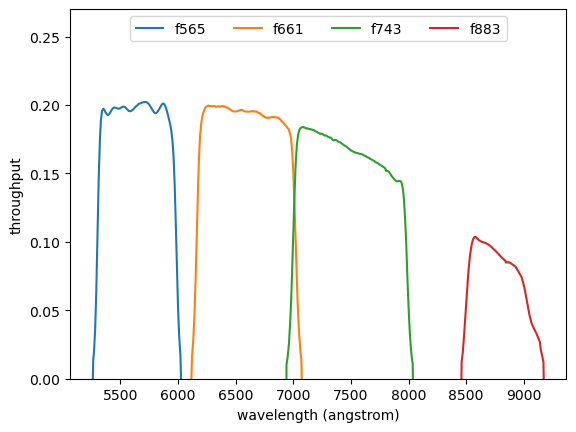
[2]:
band_names = ['f520', 'f662', 'f850', 'f720']
for band_name in band_names:
throughput = filter_throughput(band_name)
plt.plot(throughput.wave, throughput.throughput, label=band_name)
plt.xlabel('wavelength (angstrom)')
plt.ylabel('throughput')
plt.ylim(0, 0.07)
plt.xlim([4000, 10000])
#4 column legend
plt.legend(ncol=4, loc='upper center', bbox_to_anchor=(0.5, 1))
[2]:
<matplotlib.legend.Legend at 0x17d27ba50d0>
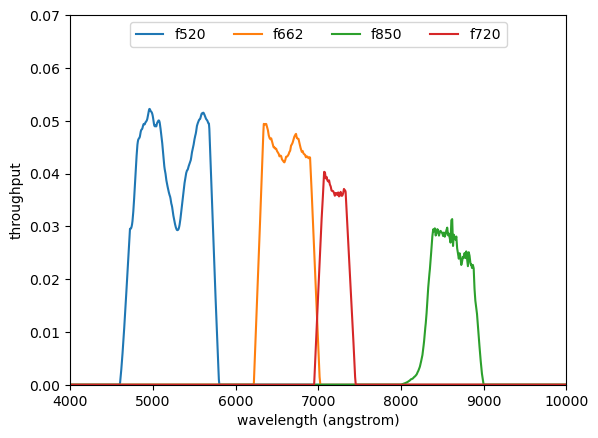
焦面图像生成功能
make_focus_image函数是焦面图像生成功能的核心函数。该函数的输入参数为观测波段、观测坐标的位置和光谱、psf生成函数、输出为2D np.array格式的焦面图像,单位为光电子/像素/秒。
[18]:
%reload_ext autoreload
%autoreload 2
import numpy as np
import matplotlib.pyplot as plt
from astropy.io import fits
from csst_cpic_sim.optics import filter_throughput, focal_convolve
# 生成一些恒星的位置和光谱
stars = [
(5, 0, 0),
(24, 0.5, 0.7),
(15, 3.1, -2.3),
(18, -1.2, 2.5),
(21, -4.1, -1.5),
]
targets = []
for magnitude, x, y in stars:
spectrum = star_photlam(
magnitude=magnitude,
sptype='G0V',
is_blackbody='True',
)
targets.append([x, y, spectrum, None])
# 生成焦面图像
focal_img = focal_convolve('f661', targets, nsample=1)
def psf_imshow(psf):
focal_img = psf.copy()
focal_img = np.maximum(focal_img, 5e-3)
# focal_img = np.minimum(focal_img, focal_img.max())
image_log = np.log10(focal_img)
plt.imshow(image_log, origin='lower', cmap='gray')
psf_imshow(focal_img)
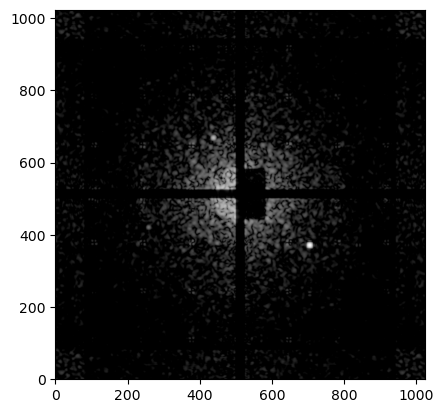
通过make_focus_image函数的rotation参数,可以实现对焦面图像的旋转。rotation参数的单位为度,逆时针为正,顺时针为负。焦面旋转模拟观测过程中望远镜的滚动旋转。
[19]:
focal_img = focal_convolve('f661', targets, nsample=1, rotation=60)
psf_imshow(focal_img)
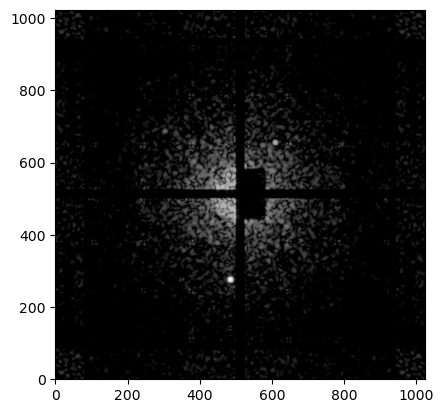
同样,可以通过make_focus_image函数的init_shift参数,实现对焦面图像的平移。init_shift参数的单位为角秒。模拟观测过程中将中央恒星偏移出视场中心的观测模式。
[20]:
focal_img = focal_convolve('f661', targets, nsample=1, rotation=60, init_shifts=[2, 2])
psf_imshow(focal_img)
